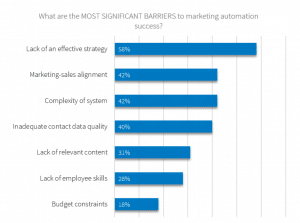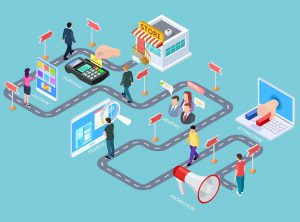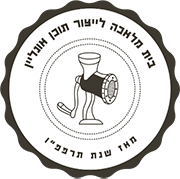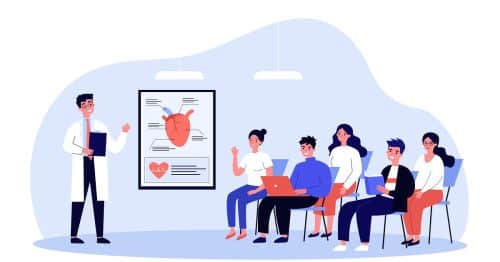One of the common questions in marketing managers groups on Facebook and LinkedIn is, “Which marketing automation tool should I implement?”. This usually sparks a technical discussion about integrating with CRM systems and specific organizational needs. It often revolves around simple email automation workflows and advanced systems that closely track the customer journey across multiple channels. However, I have rarely seen the question, “What content should I create for marketing automation?”
In many cases, the focus is on the technical and technological aspects rather than the content itself. The discussion revolves around pipelines rather than what flows through them. But what happens after we have set up the pipelines?
The gap between the implementation stage and the operational stage of marketing automation
Research conducted on the implementation of marketing automation systems reveals a significant gap between the challenges organizations anticipate and the actual challenges they encounter in practice.
One study, for example, found that the primary reasons for the non-implementation of marketing automation systems in organizations are technical concerns: lack of knowledge (55.6%) and lack of skilled personnel (48.1%). The essential aspects of producing appropriate content were pushed to the bottom of the list, with only 18% considering it a significant challenge.

In contrast, a study conducted among organizations that have already implemented marketing automation systems and were asked about the most significant barriers to success, ranked strategic absence as the top concern (58%), and the absence of relevant content as the fifth concern (31%). Another study places the absence of relevant content in the second position with 40%.
The conclusion drawn from these findings is that while technology may initially seem daunting, the real challenges in managing marketing automation systems lie in the absence of strategy and the absence of relevant content.
Content for marketing automation: The importance of context in the consumer journey
The classic definition of personalized content in marketing automation is the right content, to the right person, at the right time. What unifies these three elements? The consumer’s position in the consumer journey. It may sound simple, but in the digital age, the consumer journey has become highly complex, with knowledge-hungry consumers influenced by numerous touchpoints. Therefore, precise selection of the content delivered to them is critical for success.
Here are a few examples.
1. The return of awareness – stay always on
Google has been saying it for a long time, and it’s usually worth listening to: say goodbye to the classic marketing funnel. Even if you’ve successfully led a potential consumer from the awareness stage to the consideration stage, they continue to pay attention to other options in the awareness stage. They may be at the bottom of your marketing funnel but at the top of your competitor’s marketing funnel. In fact, there’s an injustice effect at play: the fact that you’ve put in the effort to attract a consumer in your funnel provides signals to various distribution systems, enabling your competitors to reach the same consumer as someone currently interested in purchasing a similar product. Interested in a vacation? Prepare for a deluge of offers and deals.
It may sound like an anomaly, but while you’re delivering content to a consumer at the bottom of the marketing funnel, you also need to provide them with content that belongs to the top part of the funnel. It could be that alongside the SMS reminding them to attend a mortgage consultation meeting, they need to receive social media content highlighting the need for mortgage advice and reflecting your professionalism as a trustworthy source to turn to.
2. Empowering Choice, or Friday Dinner Arsenal
Despite all the marketing and advertising efforts, one of the most influential factors on consumers is their immediate social environment: their friends and family. And as we all know, especially in Israel, everyone has something to say about consumer choices, from buying a new home to choosing a vacation destination.

Let’s say you’re interested in purchasing a new car. The consumer journey you’ve been through hasn’t been easy, but you finally decided on a model, took a test drive, and even made a down payment. Now, there’s a specific timeframe during which you need to complete the purchase, and the car dealer may sit on the edge of their seat because you’ve already committed to the payment.
But wait, not so fast. Even at this advanced stage, there’s still a possibility of a purchase cancellation, and in many cases, it happens in Israel on Sunday mornings. Why? Because of Friday dinner in which the family gathers. In This dinner, the consumer shares their decision, and suddenly their brother-in-law vigorously objects, claiming, “You’ve already paid? Don’t even touch that car”. He strengthens his position with a structured list of arguments based on half-truths and numerous myths ensues.
When identifying such failure points in the consumer journey, it’s possible to preemptively address them with content. For example, an article delivered to the consumer on Friday morning, reinforcing their consumer choice and addressing the points their family or friends may raise against the purchase, can provide the consumer with an arsenal of answers that benefit both themselves and their immediate circle.
3. Putting a Stop to Funnel Leakage
A student scheduled an appointment with an academic advisor, received a confirmation email, and even a reminder via SMS. And yet they simply didn’t show up. Phenomena like these, known as funnel leakage, can significantly impact conversion rates and harm business outcomes.
In such cases, it’s important to understand why students schedule appointments but fail to attend. Research may reveal that the reason behind this behavior is the perception that the sales meeting won’t add value but will rather waste their time. In such a scenario, instead of sending a generic SMS reminder about the appointment, it is crucial to provide the student with content that reflects the significance, usefulness, and value of the meeting with the academic advisor in facilitating decision-making.
This content can take the form of written material or a video, in the form of an infographic that explains the appointment process or a gamification process that sharpens the questions they would like to discuss during the meeting. Regardless of the chosen method to convey the value, such marketing automation content can significantly increase attendance rates for appointments.
In summary: understanding the consumer is crucial
Marketing automation is essentially a tool for delivering content to consumers. Understanding the consumer, their needs, challenges, and their position in the consumer journey is essential for creating marketing automation content that brings tangible business results.
Remember? The consumer is king, and content is their best friend.



